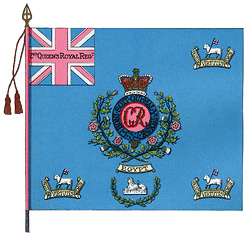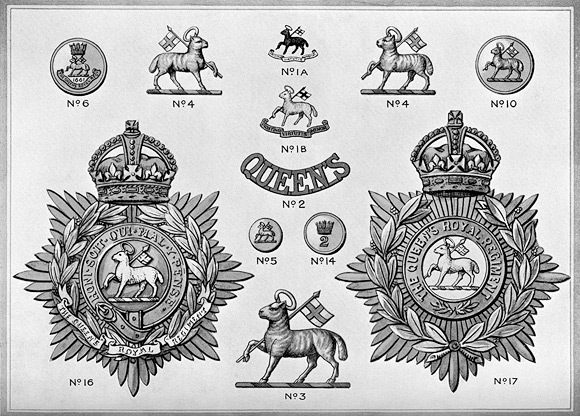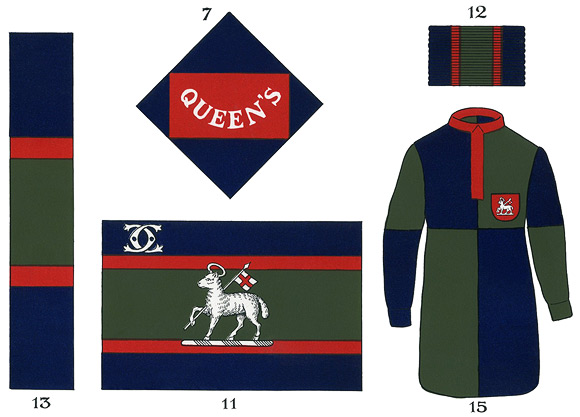In Search of The Lamb
Regimental Badges, Buttons, etc.
| Extracts From The Report of the Committee Appointed By General Sir Charles Monro, BT., G.C.B., G.C.S.I., G.C.M.G., Colonel Of The Regiment, In 1922, To Consider Certain Matters Of Regimental Interest Set Out In Their Terms Of Reference And To Make Recommendations Thereon. |
Terms of Referance
In recent years it has been the practice of each Battalion of the Regiment (Regular Battalions, Depot and Territorial Battalion alike) to adopt on Uniform, Regimental Plate, Official and unofficial notepaper, cards, etc., a varied form of Regimental title, varied styles of Regimental crest, badges, buttons, numerals and other items, without regard to authority or Regimental tradition.
A departure from the correct pattern of the Regimental colours in ties, scarves; blazers, and other articles of dress for recreational purposes is also noticeable.
It is considered advisable that uniformity in these and kindred matters should be secured throughout the Regiment in all Battalions and component Units.
With this object in view and at the suggestion of General Sir C. C. Monro, Bt., G.C.B., G.C.S.I., G.C.M.G., Colonel of the Regiment, and with the full concurrence of the Officers Commanding 1st and 2nd Battalions, it has been decided to appoint a Committee, composed as follows, to examine the subject :-
Lieut.-Col. C. Parsons, D.S.O.,. Reserve of Officers |
|
Chairman. |
Major W. H. Alleyne, Reserve of Officers |
|
Member. |
Major G. N. Dyer, D.S.O., The Queen's Royal Regt. |
|
Member. |
The Committee to submit their report to General Sir C. C. Monro, Bt. |
||
Definition Of The Subjects To Be Considered By The Committee
1. Official.
- Title of the Regiment for all official purposes, and abbreviations thereto, including those for Q.M. marking, marking vehicles, etc.
- The Regimental Crest.
- Styles of shoulder, collar, cap and helmet badges for every article of uniform, including foreign pattern helmet, whether they shall be bright or dull on service dress and khaki drill.
- Types of button for all articles of uniform.
- Patches.
- Identity discs.
2. Regimental.
- Title of the Regiment for all unofficial and private purposes, invitation cards, visiting cards, and any legitimate abbreviation thereof.
- Crest on Regimental Plate.
- Style and size of crest on notepaper, invitation cards, menus, band programmes, etc.
- Buttons on servants' liveries.
- Type and size of Regimental Camp Colour.
3. Recreational.
- Correct pattern and shade of Regimcntal Games colours generally.
- Ties, hatbands, sashes, scarves, width of stripes.
- Blazers, football shirts and jerseys, with descriptive pattern of each; buttons.
- Boundary flags, badge, etc.
4. Any other item not specifically provided for above which, in the course of investigation, may come to light and which the Committee may consider it advisable to include in their suggestions and recommendations. In all cases the Committee are requested to provide for Officers, W.Os., N.C.Os. and men collectively or respectively as the case may necessitate.
|
(Signed) |
H. C. WHINFIELD, Lieut.-Col., |
COUNTERSIGNED. |
|
|
|
(Signed) |
C. C. MONRO, General, |
Forword
In framing their recommendations, the Committee have had as their first consideration the maintenance of Regimental tradition.
The interest of each Battalion and Unit comprising the Regiment and the needs of all ranks respectively have been carefully borne in mind.
In respect of articles of uniform governed by Regulations only, such recommendations have been put forward as are in conformity with the orders on the subject and fulfil military requirements.
In respect of other items, the Committee have had regard to Regimental custom. The recommendations made express the unanimous opinion of the three members of the Committee, arrived at only after searching investigation and thorough discussion of every item under review.
Report
The Committee recommend as follows :-
1. Official.
(a) Title of the RegIment.
THE QUEEN'S ROYAL REGIMENT as here spelt. Considerations of space may in some cases necessitate the substitution of REGT. for REGIMENT.
Abbreviations :-
- For the purposes referred to in the schedule to Army Order 509 of 1920 to be as stated therein.
- For Quartermaster's markings – Q.R.R.
- For vehicles – As and when ordered or permitted to be marked with the name of the Unit, then QUEEN'S preceded by the designation of the particular unit – e.g., 1ST BN. QUEEN'S; 1ST C BN. QUEEN'S.
Comment
The above recommendations are based on Army Order 509 of 1920.
(b) The Regimental Crest.
A "Paschal Lamb" bearing pole and flag, surmounted on a scroll with motto PRISTINE VIRTUTIS MEMOR, strictly in accordance with a drawing obtained from the College of Arms, of which Design No. 1 is a copy.
See also Para. 2 (c) on this subject.
Argument
To this important question, governing as it does our recommendations as to the style of all badges and type of Lamb on all buttons, very special attention has been paid. We have it on the authority of Garter King of Arms in his capacity as Inspector of Regimental Colours that the ancient and historical crest of the Regiment, as registered at the College of Arms, is a Paschal Lamb, bearing on the" off " shoulder a pole to which is affixed a flag rectangular in shape, the whole surmounted on a scroll with motto PRISTINE VIRTUTIS MEMOR.
On the Colour, circa 1806, illustrated opposite page 68, Vol. IV, of Colonel John Davis' History of the Regiment the flag is thus shown, though this illustration does not bear out the contention that the pole is borne on the" off " shoulder.
Turning to the existing Colour of the 1st and 3rd Battalions, we find the design of the College of Arms carried out in all respects. When or by what authority the flag borne by the Lamb was converted into a "pennon" or "fishtail," or flown as a banner, we have not been able to discover, but it is to be found in that form in the volume above referred to opposite page 263 and thereafter in almost every illustration of more recent date and on all badges which we have examined.
 |
| Regimental Colours 1806 |
The existing Regimental Colour, dating from 1857, of the 2nd Battalion also shows the flag in "fishtail" form. In 1889 this Colour was practically remade, as on the return of the Battalion from Burmah there was little of it left but pole and tassels. The arrangements for remaking were made with a firm privately by an officer deputed by the 2nd Battalion to do so, and we are forced to the conclusion that this officer accepted – erroneously, we think – the type and style of badge then in use as the authentic and historically correct design of crest. That the Paschal Lamb is the ecclesiastical badge of St. John the Baptist, and is also the badge of the Merchant Taylors Guild, renders it the more important that in the case of the Regimental Crest historical accuracy should be preserved in all its details. The most recent illustration of this principle is the crest on the" Book of Life" which forms part of the Regimental War Memorial in the Holy Trinity Church, Guildford. It seems to us superfluous to indicate on a scroll, as has been the practice in recent years, the particular Regiment to which a crest belongs. It is not done in the case of crests belonging to old English families, mottoes only are used, and we recommend the use of the motto only in this case also. To the uninitiated, when the crest is used on official documents, Mess plate, band programmes, invitation cards, and such like,' there are usually other indications which denote the title of the Regiment. With unofficial notepaper the writer can adopt such explanations as may appear to him necessary.
A suggestion that the number of the Battalion be stated under the crest does not fmd favour with the Committee; in their opinion it is contrary to the fundamental idea of a united family having a crest, customs, and traditions in common.
(c) Badges.
We regard the type of badge-viz., a plain Lamb--worn by Officers prior to 1900 as the most suitable for every article of uniform, both for Officers and Other Ranks, on which a badge is worn. A scroll is unnecessary and would, in our opinion, with the lengthened title, be clumsy. Moreover, identification is provided by numerals on the shoulder, when worn.
We recommend– |
|
|
(i) Shoulder Badges or Numerals Design No. 2. |
|
DesIgn No. 3. |
(ii) Cap Badge |
|
|
(iii) Foreign Service Helmet Badge |
|
|
(iv) Badge on Satchel worn by Band and Drums, Orderlies, etc. |
|
|
(v) Collar Badges |
|
Design No. 4. |
(vi) Officers' Mess Jacket |
|
A pair of gold embroidered badges |
Note.– The badges worn by Officers and Other Ranks (a) in khaki drill to be bright, (b) in khaki service dress to be bronzed.
Helmet Plates
- Other Ranks: Abolish WEST SURREY and substitute THE QUEEN'S ROYAL REGIMENT:. Design No. 17.
- Officer': Same as for Other Ranks, Design No. 17, but of same quality as the old Officers' Helmet Plate.
It is possible, however, that Headquarters may not consent to the abolition of the standard type of helmet plate for Officers, in which case we recommend as follows :Abolish the existing silver scroll at the top. The silver scroll at the base to bear the title THE QUEEN'S ROYAL REGIMENT-Design No. 16.
On any belt buckle, clasp or other article on which WEST SURREY appears, substitute THE QUEEN'S ROYAL REGIMENT.
Comments
With regard to (v), it is to be noted that the collar badge worn on the right side of the collar differs slightly from the orthodox pattern. It is clear that with this badge the pole cannot be borne on the" off " shoulder of the Lamb, and meticulous accuracy must give way to symmetry in appearance. The pole is therefore placed on the " hidden" shoulder and the further leg suspended.....
As regards (vi) the above remarks apply, Designs of gold embroidered badges are not appended· owing to the cost of production. For type see Design NO.4.

Designs of Regimental Badges, Buttons, Etc.
(d) Buttons.
OFFICERS. |
|
|
(i) Mess Jacket. Half dome gilt button with silver Lamb |
|
DesIgn No. 5. Each in its |
(ii) Mess Waistcoat. Ditto |
|
|
(iii) Blue Forage Cap. Ditto, all brass. |
|
|
(iv) Khaki Forage Cap. Ditto, all bronze. |
|
|
(v) Tunic and other uniform, large, brass |
|
Design No. 6. |
(vi) Tunic and other uniform, small, brass |
|
Same design as its |
Comment
Items (v) and (vi) will require the official approval of the War Office, and must conform to the recognized type of military button, therefore the title of the Regiqtcnt has been included in the design, though opposed to our recommendation in I (b) and (c).
The Tudor Crown has been replaced by the Naval Crown (a correct drawing of which was obtained from the College of Arms), which the Regiment has authority to wear in recognition of valuable services rendered by it on board H.M.S. Queen Charlotte in action on the Glorious 1st of June, 1794, emphasizing the relationship and traditional goodwill which exists between the Regiment and the Royal Navy.
OTHER RANKS. |
|
|
In full dress |
|
Design No.6 (as for Officers). |

Comment
It is understood that the Army Council have already given approval for a Regimental button to be worn by Other Ranks in full dress (as recommended by Sir Archibald Murray's Committee) when again it is taken into wear. Therefore we suggest that timely application be made accordingly in respect of the design.
See also para. 4 (d).
Related Links
